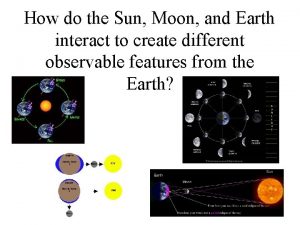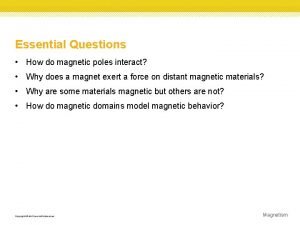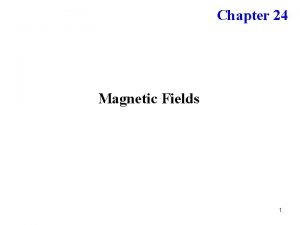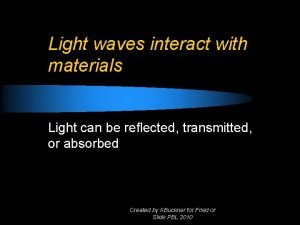T Take Notes I Interact with your notes



























- Slides: 27

T = Take Notes I = Interact with your notes P = Practice with plenty of repetition S = Self-test

CHAPTER 4: SECTION 3: ELECTRON CONFIGURATION

ESSENTIAL QUESTIONS • How does electron arrangement determine atomic properties? • How are valence electrons related to families on the periodic table? • What are electron configurations useful for? • What are the periodic trends in atomic radius, ionic radius and ionization energy?

6. 2 SUBLEVELS • Blocks of Elements

6. 2 BLOCKS OF ELEMENTS

WRITING AN ELECTRON CONFIGURATION • An electron configuration describes how electrons are distributed among s, p, d, and f orbitals

THE NOBLE GASES • Noble gases have full outermost s and p orbitals • These outermost electrons determine chemical behavior • Electrons in completely filled energy levels are not available to form chemical bonds. • Electrons in unfilled energy levels are available to form chemical bonds.

GROUP I: ALKALI METALS • The alkali metals (group 1) all lose an electron easily. • They form +1 ions. • Once they lose an electron they have full energy levels.

GROUP II METALS: ALKALINE EARTH METALS • The alkaline earth metals (group 2) all lose an electron 2 easily. • They form +2 ions. • Once they lose two electrons they have full energy levels.

THE HALOGENS • The halogens (group 17) all gain an electron easily. • They form -1 ions. • Once they gain an electron they have full energy levels.

CARBON, NITROGEN, AND OXYGEN • Carbon, nitrogen, and oxygen are among the most important elements to life. • Oxygen and nitrogen both tend to accept electrons, rather than donate them. • Carbon can go either way, sometimes accepting electrons and sometimes donating them.

VALENCE ELECTRONS • Electrons that are in highest energy levels are called valence electrons. • Valence electrons participate in chemical bonds

VALENCE ELECTRONS • Valence electrons are lost or gained in ionic bonds and are shared in covalent bonds • Electrons that are in highest energy levels are called valence electrons. • Valence electrons participate in chemical bonds

SOLVED PROBLEM Determine the number of valence electrons for boron. Given The element is boron, atomic number 5 Relationship The order of filling orbitals is: s 1 s 22 p 63 s 23 p 6 4 s 23 d 104 p 6 5 s 24 d 105 p 6 6 s 24 f 145 d 106 p 6 Valence electrons are electrons in the highest populated energy level. Solve Boron has five electrons, therefore its electron configuration is: 1 s 22 p 1 The 1 s shell is full so does not count towards valence. There are three electrons in the second energy level, which is the highest energy level in boron's configuration.

SOLVED PROBLEM Determine the number of valence electrons for phosphorus (P). Given The element is phosphorus, atomic number 15 Relationship The order of filling orbitals is: s 1 s 22 p 63 s 23 p 6 4 s 23 d 104 p 6 5 s 24 d 105 p 6 6 s 24 f 145 d 106 p 6 Valence electrons are electrons in the highest populated energy level. Solve Phorphorus has 15 electrons, therefore its electron configuration is: 1 s 22 p 63 s 23 p 3 The 1 s, 2 s, and 2 p orbitals are full so the first and second energy levels do not count towards valence. There are 5 electrons in the third level. Answer Phosphorus has five valence electrons.

TRANSITION METALS • The transition metals are the elements in the middle of the periodic table. • The transition metals all have electrons in d orbitals.

NOBLE GAS CORE NOTATION • For elements past the 2 nd row of the periodic it is tedious to write the entire electron configuration, especially when the real importance is only the valence electrons. • Chemists have a short-hand way to write complex electron configurations using the noble gas core.

USING ELECTRON CONFIGURATIONS • Electron configurations are helpful for identifying an element • Configurations are also useful for predicting or explaining a chemical behavior

SOLVED PROBLEM Name the first three elements that have a p 2 valence electron configuration. What do all 3 elements have in common? The problem specifies valence electrons - so these are the highest populated energy level. Relationshi The order of filling orbitals is: ps 1 s 22 p 63 s 23 p 6 4 s 23 d 104 p 6 5 s 24 d 105 p 6 6 s 24 f 145 d 106 p 6 The first element with 2 p 2 valence electrons has electron configuration: 1 s 22 p 2 or [He]2 s 22 p 2 This is carbon, because it has six electrons and an atomic number of six. The next element with 3 p 2 valence electrons has electron Solve configuration: 1 s 22 p 63 s 23 p 2 or [Ne]3 s 23 p 2 This element has 14 electrons and therefore is silicon. The next element with 4 p 2 valence electrons has electron configuration: 1 s 22 p 63 s 23 p 64 s 23 d 104 p 2 or [Ar]4 s 23 d 104 p 2 This element has 32 electrons and therefore is germanium. Given

ELECTRON CONFIGURATIONS & THE PERIODIC TABLE • The repeating pattern in electron configuration explains the repeating pattern in chemical behavior • Elements within the same group (except He) share last-filled orbital configurations

SOLVED PROBLEM Name two elements that will have similar chemical behavior to calcium (Ca). Given Relationshi ps Solve Answer Calcium has atomic number 20 and electron configuration: 1 s 22 p 63 s 23 p 64 s 2 Elements with similar valence electrons have similar chemical properties. Beryllium has a 2 s 2 valence electron configuration and magnesium has 3 s 2 valence electron configuration. Since both of these elements have the same valence electron configuration they will have similar chemical properties. For example, each combines with oxygen in a 1: 1 ratio to make Be. O, Mg. O, and Ca. O. Beryllium and magnesium also have a s 2 valence electron configuration and will have similar chemical properties to calcium.

Post-assessment • How does electron arrangement determine atomic properties?

Post-assessment • How does electron arrangement determine atomic properties? – Valence electrons determine an element's reactivity; a filled valence is more stable than an unfilled one.

Post-assessment • How are valence electrons related to families on the periodic table?

Post-assessment • How are valence electrons related to families on the periodic table? – Elements within the same family have the same number of valence electrons.

Post-assessment • What are electron configurations useful for?

Post-assessment • What are electron configurations useful for? – Electron configurations can help you identify an element or predict chemical behavior.
 Take a bus or take a train
Take a bus or take a train Oblate sheroid
Oblate sheroid How does biosphere interact with hydrosphere
How does biosphere interact with hydrosphere Competitive interaction
Competitive interaction Parasitism mutualism and commensalism
Parasitism mutualism and commensalism How do the sun moon and earth interact
How do the sun moon and earth interact Earth four spheres
Earth four spheres How do magnetic poles interact?
How do magnetic poles interact? Sphere interactions
Sphere interactions Tectonic plates interact at places called plate
Tectonic plates interact at places called plate Interact club handbook
Interact club handbook Organizing students to interact with content
Organizing students to interact with content How do similar (s-s or n-n) magnetic poles interact?
How do similar (s-s or n-n) magnetic poles interact? Lycanthropic culture shock
Lycanthropic culture shock Regularly and consciously interact with one another
Regularly and consciously interact with one another Sergeant at arms responsibilities
Sergeant at arms responsibilities Answer
Answer Body in dance elements
Body in dance elements Identify the examples of interactional vandalism.
Identify the examples of interactional vandalism. Interact
Interact Interact
Interact Body interact answers
Body interact answers Interact conference 2018 teachstone
Interact conference 2018 teachstone Kesler science electromagnetic spectrum answer key
Kesler science electromagnetic spectrum answer key Interact
Interact Give us your hungry your tired your poor
Give us your hungry your tired your poor To take notes in spanish
To take notes in spanish Sit down and take notes
Sit down and take notes



















































